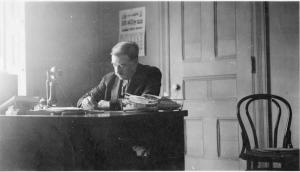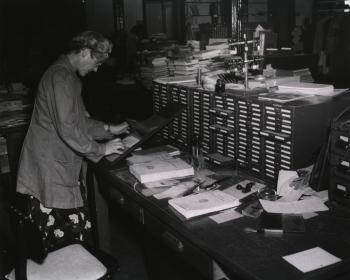
Science Service's first director E. E. Slosson ardently supported the rights of women, in the home and workplace, as well as at the ballot box. Slosson's egalitarian attitudes and reputation for frankness were so well known that even leaders in the woman's movement sought his advice.
Emma P. Huth, director of the Bureau of Vocational Information, for example, told Slosson that the Bureau's report Women and Chemistry must convey "no more optimism with reference to women in the field than the facts support." "Is there or will there be place for more" women in chemistry, she asked, and "do the prospects for women justify the long training required of them." (Emma P. Huth to E. E. Slosson, February 9, 1922, Record Unit 7091, Box 15, Folder 2). Slosson and Huth knew that young women faced many obstacles in training for the sciences, but finding employment in a laboratory could be difficult, especially after marriage.
One way in which Slosson made a difference during the 1920s was by recruiting science-trained women to be Science Service writers, either on the permanent staff or as "stringers," contributors paid by the word. Marjorie McDill Breit, for example, had worked on the staff before her marriage in 1927 to physicist Gregory Breit, and she continued to contribute articles under her maiden name over the next decade. Although Marjorie's husband was supportive, not every scientist approved of popularizing science through the newspapers. By using a pen name, a wife could "protect" a husband from potential criticism from intolerant colleagues.
 In October 1921, when Slosson sent the manuscript "What Is Known about Cancer" to the United Features Syndicate, he explained that "Edith E. Taussig is the maiden name and pen name of Mrs. Spaeth, wife of one of the leading zoologists of the country, a professor at Johns Hopkins University, but she does not want her married name of Spaeth to be used in connection with her writing."
In October 1921, when Slosson sent the manuscript "What Is Known about Cancer" to the United Features Syndicate, he explained that "Edith E. Taussig is the maiden name and pen name of Mrs. Spaeth, wife of one of the leading zoologists of the country, a professor at Johns Hopkins University, but she does not want her married name of Spaeth to be used in connection with her writing."
Edith Eleanor Taussig (1888-1968), Wellesley College Class of 1910, had married Reynold Albrecht Spaeth (1886-1925) in 1913, as he was completing a graduate fellowship in zoology at Harvard and she was engaged in graduate study at Radcliffe. For the next five years, the Spaeths lived the peripatetic life typical of rising young scientists, as he traveled in Europe, taught at Clark College and Yale University, and spent time at the Marine Biological Laboratory at Woods Hole, Massachusetts. In 1918, Reynold Spaeth joined the faculty of the School of Hygiene and Public Health at Johns Hopkins University and the couple settled in Baltimore.
Slosson had begun professional interactions with Edith soon after the establishment of Science Service. Within a few months she was submitting manuscripts, suggesting articles on such topics as beriberi, pellagra, and rickets research, seeking feedback on her writing style, asking when checks would arrive, and quibbling over how little money they paid.
In his letters, Slosson pled for patience and accommodation. The organization's goal was the widest possible syndication for science (that is, to reach a large audience) but that required a more popular style and brought in lower revenue per piece. Edith wondered whether Woman’s Home Companion might "bite" on the next manuscript, and was disappointed when only a few newspapers picked up her cancer story. Slosson responded by challenging her to write something "sufficiently brilliant" to captivate the attention of The Century. "It is more important that the subject should be written up strikingly than that it should be novel in the scientific sense," he advised. And "if an item is connected with some current event or topic of conversation," it is more apt to be accepted: "You will have to use your prophetic power and womanly intuition in such cases."
 Edith confessed to being "floored" by the call to "brilliancy" but she kept at the effort, as Slosson patiently schooled her ("You put too much meat into your preparations. Remember that a housewife's skill is based on her ability to make a tasty dish out of a scrap of left-over.") Even when she continued to challenge the payment amounts, he remained polite and supportive. They tried her out for a few weeks on the permanent staff but, Slosson later explained, she could never quite adapt to the necessary journalistic approach and she remained a regular external contributor.
Edith confessed to being "floored" by the call to "brilliancy" but she kept at the effort, as Slosson patiently schooled her ("You put too much meat into your preparations. Remember that a housewife's skill is based on her ability to make a tasty dish out of a scrap of left-over.") Even when she continued to challenge the payment amounts, he remained polite and supportive. They tried her out for a few weeks on the permanent staff but, Slosson later explained, she could never quite adapt to the necessary journalistic approach and she remained a regular external contributor.
Unfortunately, within a few years, Edith's life took a tragic turn. Reynold and the family had moved to Siam, where he was involved in Rockefeller Foundation research at the University of Bangkok Medical School. In 1925, Reynold died suddenly at the age of 38.
Slosson, like many other friends in the United States, reached out to Edith and her two small children, and attempted to negotiate some way she might find employment in science journalism. Reynold's brother Sigmund was supportive of this offer ("My brother's death was a sacrifice to science, and there would be some consolation in the thought that his widow could be useful in the same cause"). Slosson agreed that she was "putting up a plucky fight and should have all possible encouragement and help in this emergency," and offered several possibilities, including writing a children's book for a series he was editing. He admired her ability to be frank and to take honest reactions with grace. Despite his offer of a "living wage" on the staff and all the training she might need, however, he told her "it would be a waste of time and an annoyance to us both" if she could not adapt to "the requirements of the newspapers we serve."
Edith Taussig Spaeth eventually chose a different path, finding work as a medical librarian. But she nevertheless expressed her gratitude for Slosson's honest advice. False optimism, they both recognized, would never serve any woman well in the struggle for equality in the workplace.
Related Collections
- Science Service Records at the Smithsonian Institution Archives
Produced by the Smithsonian Institution Archives. For copyright questions, please see the Terms of Use.

Leave a Comment